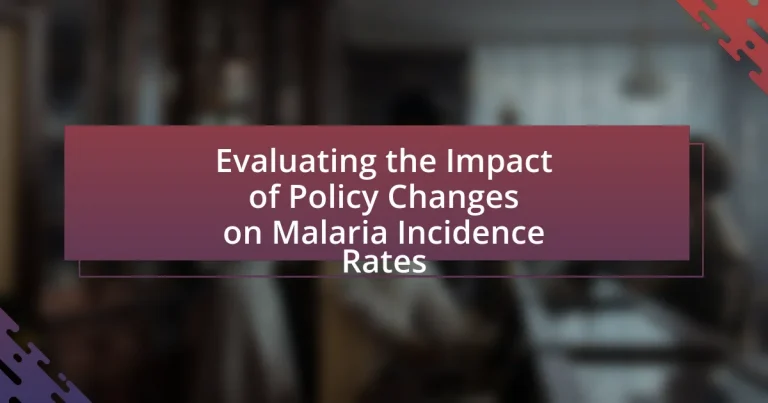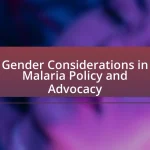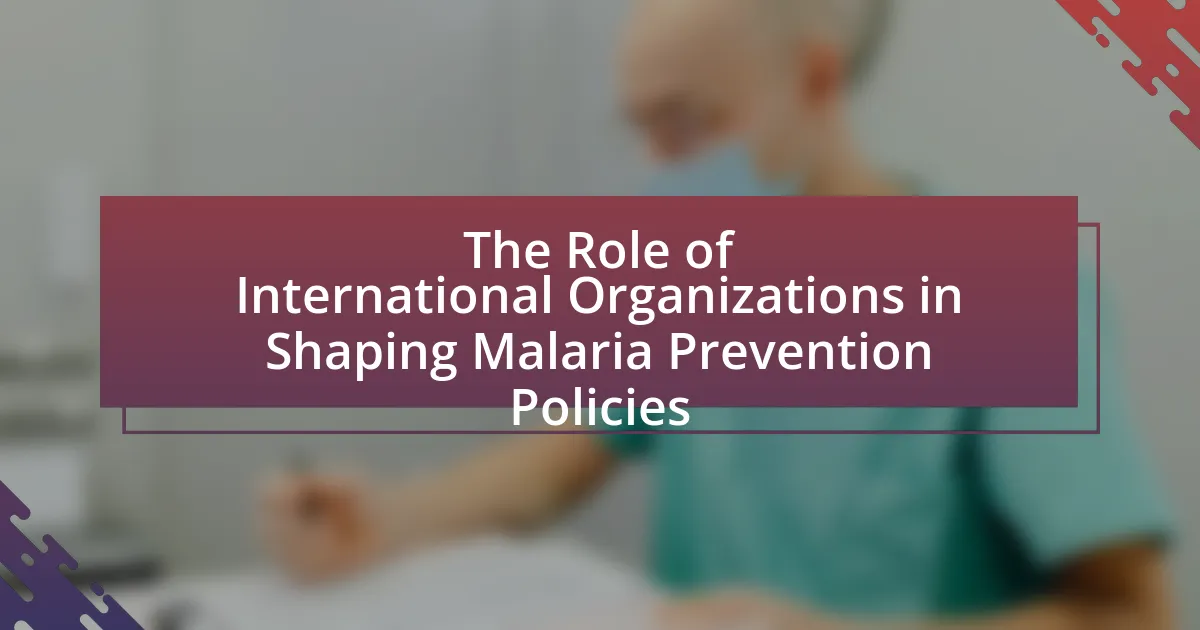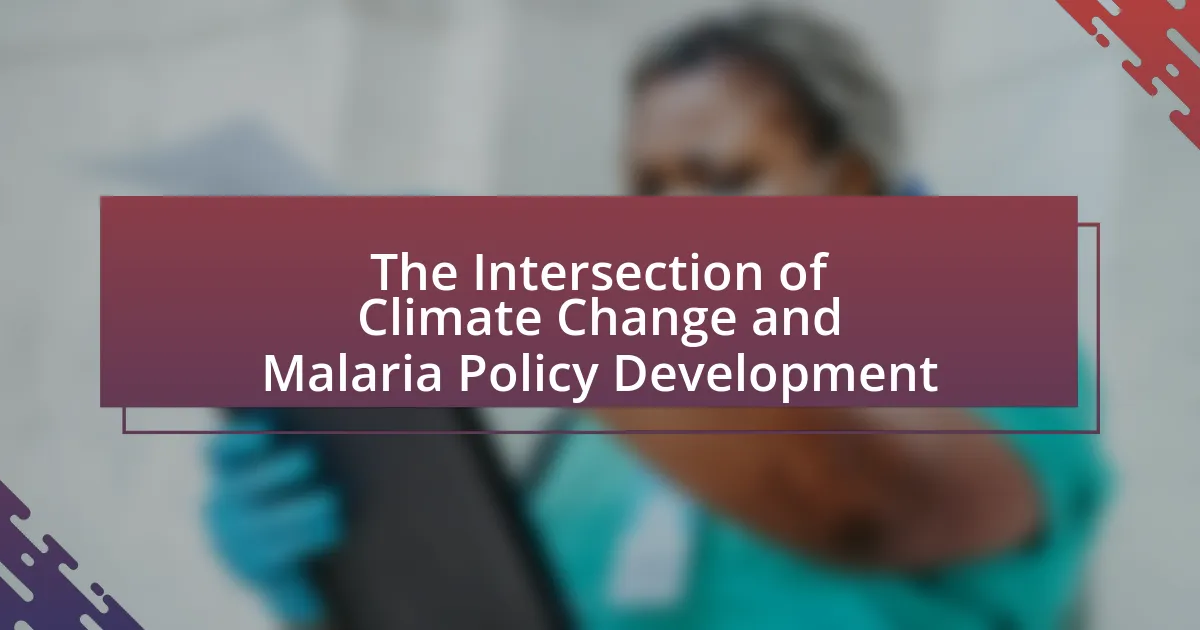The article evaluates the impact of key policy changes on malaria incidence rates, focusing on interventions such as universal access to insecticide-treated nets (ITNs), rapid diagnostic tests (RDTs), and the scaling up of artemisinin-based combination therapies (ACTs). It discusses how these policies have led to significant reductions in malaria cases in various regions, supported by data from the World Health Organization. The article also examines the role of government and international organizations in implementing these policies, the influence of funding and resources on their effectiveness, and the importance of partnerships for successful malaria control. Additionally, it highlights the challenges in measuring policy impacts and the lessons learned from past evaluations to improve future malaria control strategies.
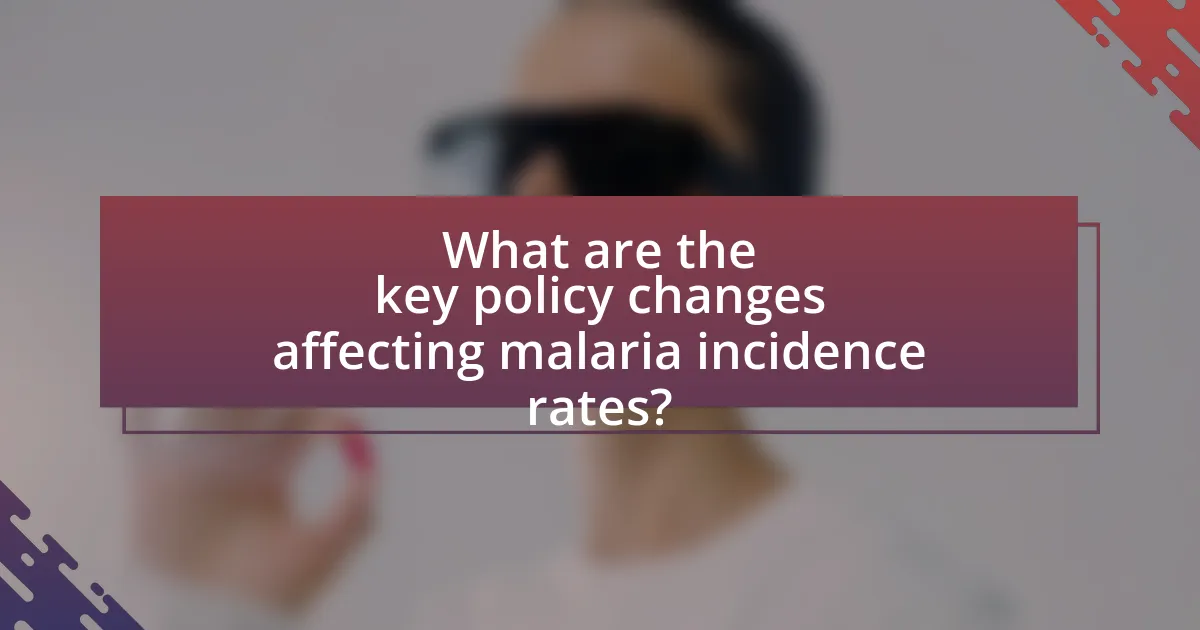
What are the key policy changes affecting malaria incidence rates?
Key policy changes affecting malaria incidence rates include the implementation of universal access to insecticide-treated nets (ITNs), the introduction of rapid diagnostic tests (RDTs), and the scaling up of artemisinin-based combination therapies (ACTs). Universal access to ITNs has been shown to reduce malaria transmission significantly; for instance, countries like Zambia reported a 50% decrease in malaria cases after widespread distribution of ITNs. The introduction of RDTs has improved case detection and treatment rates, leading to timely interventions that reduce morbidity and mortality. Additionally, the scaling up of ACTs has enhanced treatment efficacy, contributing to lower incidence rates in regions where malaria is endemic. These policy changes are supported by data from the World Health Organization, which indicates that comprehensive malaria control strategies can lead to substantial declines in malaria incidence.
How do these policy changes influence malaria prevention strategies?
Policy changes significantly influence malaria prevention strategies by reallocating resources and prioritizing interventions based on updated epidemiological data. For instance, the introduction of policies that emphasize the distribution of insecticide-treated bed nets has been shown to reduce malaria transmission rates by up to 50% in high-risk areas, as evidenced by studies conducted in sub-Saharan Africa. Additionally, policies that promote rapid diagnostic testing and effective treatment protocols enhance early detection and management of malaria cases, leading to decreased morbidity and mortality. These strategic shifts in policy not only improve the efficiency of malaria control programs but also align funding and support towards evidence-based practices that have demonstrated success in reducing malaria incidence.
What specific policies have been implemented in recent years?
Recent years have seen the implementation of specific policies aimed at reducing malaria incidence rates, including the widespread distribution of insecticide-treated bed nets, the introduction of rapid diagnostic tests, and the scaling up of artemisinin-based combination therapies. These policies have been supported by global initiatives such as the Global Fund to Fight AIDS, Tuberculosis and Malaria, which reported that over 1 billion bed nets were distributed between 2002 and 2019, significantly contributing to the decline in malaria cases in several regions. Additionally, countries like Nigeria and Ghana have adopted national malaria control strategies that emphasize preventive measures and treatment accessibility, leading to measurable decreases in malaria morbidity and mortality.
How do these policies differ across regions?
Policies addressing malaria incidence rates differ significantly across regions due to variations in local transmission dynamics, healthcare infrastructure, and socio-economic factors. For instance, Sub-Saharan Africa often emphasizes insecticide-treated nets and indoor residual spraying, while Southeast Asia may focus more on artemisinin-based combination therapies due to differing malaria strains. Additionally, regions with stronger healthcare systems, like parts of Latin America, implement more comprehensive surveillance and response strategies, leading to lower incidence rates. These differences are supported by data from the World Health Organization, which highlights that tailored interventions based on regional epidemiology are crucial for effective malaria control.
What role do government and international organizations play in these policy changes?
Governments and international organizations play a crucial role in shaping policy changes that impact malaria incidence rates. Governments implement national health policies, allocate funding, and establish regulations that facilitate malaria prevention and treatment initiatives. For instance, the World Health Organization (WHO) provides guidelines and technical support to countries, helping them adopt effective malaria control strategies. Additionally, international organizations like the Global Fund mobilize resources and coordinate efforts among nations to combat malaria, evidenced by their investment of over $4 billion in malaria programs since 2002. These collaborative efforts lead to significant reductions in malaria cases and deaths, demonstrating the effectiveness of coordinated policy changes.
How do funding and resources impact policy effectiveness?
Funding and resources significantly impact policy effectiveness by determining the scope and reach of interventions. Adequate financial support enables the implementation of comprehensive malaria control programs, including prevention, treatment, and education initiatives. For instance, the Global Fund to Fight AIDS, Tuberculosis and Malaria reported that increased funding led to a 50% reduction in malaria mortality rates in several African countries between 2000 and 2015. This demonstrates that sufficient resources are crucial for executing effective policies that can lead to measurable health outcomes, such as decreased malaria incidence rates.
What partnerships are crucial for successful policy implementation?
Crucial partnerships for successful policy implementation in the context of malaria incidence rates include collaborations between government agencies, non-governmental organizations (NGOs), healthcare providers, and international health organizations. These partnerships facilitate resource sharing, enhance data collection, and improve community outreach efforts. For instance, the World Health Organization (WHO) collaborates with local governments and NGOs to implement malaria control programs, which has been shown to reduce malaria incidence significantly in various regions. Such partnerships leverage diverse expertise and resources, ensuring comprehensive strategies that address the multifaceted challenges of malaria prevention and treatment.
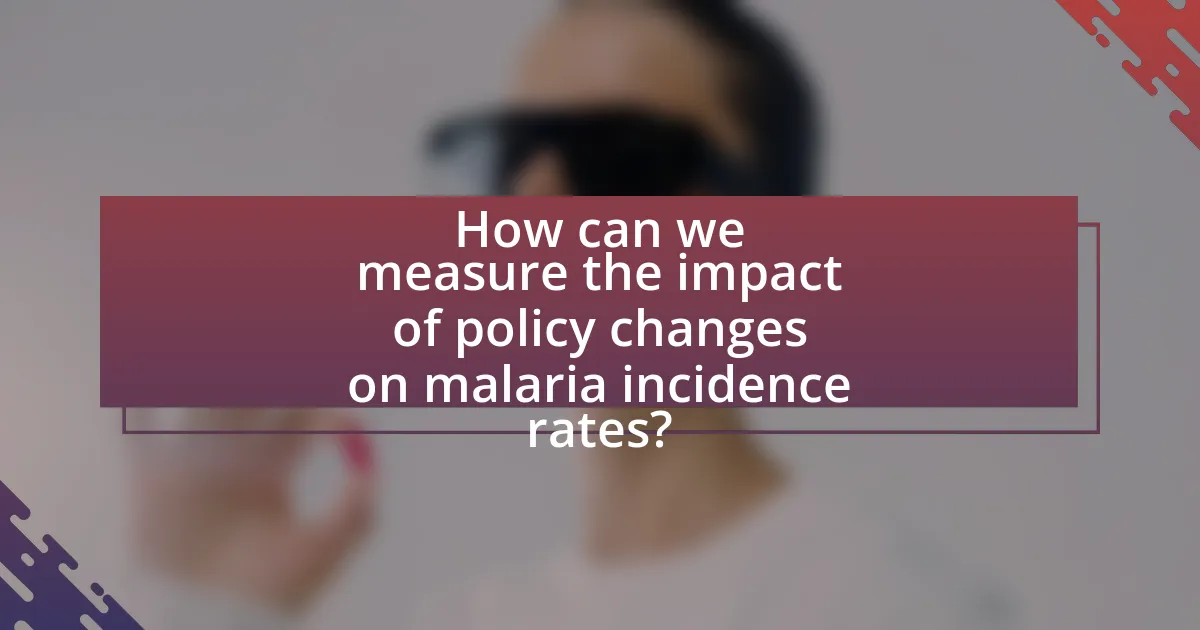
How can we measure the impact of policy changes on malaria incidence rates?
To measure the impact of policy changes on malaria incidence rates, researchers can utilize a combination of statistical analysis, epidemiological studies, and surveillance data. By comparing malaria incidence rates before and after the implementation of specific policies, such as increased access to insecticide-treated nets or changes in treatment protocols, researchers can identify trends and correlations. For instance, a study published in the Lancet Infectious Diseases demonstrated that the introduction of a national malaria control program in Zambia led to a 50% reduction in malaria cases over five years, illustrating the effectiveness of targeted policy interventions. Additionally, employing control groups and adjusting for confounding variables enhances the validity of the findings, allowing for a clearer understanding of the policies’ direct effects on malaria incidence.
What metrics are used to evaluate malaria incidence rates?
Malaria incidence rates are primarily evaluated using metrics such as the number of confirmed malaria cases per 1,000 population at risk, the incidence rate per 100,000 population, and the proportion of positive malaria tests among suspected cases. These metrics provide a quantitative assessment of malaria’s prevalence and transmission dynamics within a specific population. For instance, the World Health Organization (WHO) recommends using these metrics to monitor trends over time and assess the effectiveness of malaria control interventions, which is crucial for understanding the impact of policy changes on malaria incidence.
How do we collect data on malaria cases before and after policy changes?
Data on malaria cases before and after policy changes is collected through systematic surveillance systems, health facility reports, and community-based surveys. These methods involve tracking malaria incidence rates over time, utilizing standardized case definitions, and ensuring consistent data collection protocols. For instance, the World Health Organization recommends using routine health information systems to gather data from clinics and hospitals, which helps in assessing the impact of interventions. Additionally, community surveys can provide insights into malaria prevalence and treatment-seeking behavior, allowing for a comprehensive evaluation of policy effectiveness.
What statistical methods are employed to analyze this data?
Statistical methods employed to analyze data on malaria incidence rates include regression analysis, time series analysis, and chi-square tests. Regression analysis helps in understanding the relationship between policy changes and malaria incidence by modeling the impact of various factors. Time series analysis is utilized to examine trends over time, allowing researchers to assess the effects of policy changes on malaria rates across different periods. Chi-square tests are applied to determine the association between categorical variables, such as the presence of specific policies and changes in malaria incidence. These methods provide a robust framework for evaluating the effectiveness of policy interventions on malaria control.
What challenges exist in measuring the impact of these policies?
Measuring the impact of policies on malaria incidence rates faces several challenges, primarily due to the complexity of malaria transmission dynamics. One significant challenge is the difficulty in isolating the effects of specific policies from other influencing factors, such as environmental changes, healthcare access, and population movement. For instance, a study published in the journal “Malaria Journal” by Killeen et al. (2017) highlights that variations in malaria transmission can occur due to seasonal changes and climatic conditions, complicating the attribution of changes in incidence rates solely to policy interventions. Additionally, data collection can be inconsistent, as many regions lack reliable health information systems, making it hard to obtain accurate baseline and follow-up data necessary for effective evaluation. These factors collectively hinder the ability to draw definitive conclusions about the effectiveness of malaria control policies.
How do external factors complicate the evaluation process?
External factors complicate the evaluation process by introducing variables that can skew results and obscure causal relationships. For instance, changes in environmental conditions, such as climate variations, can influence malaria transmission rates independently of policy changes, making it difficult to attribute observed outcomes solely to the implemented policies. Additionally, socio-economic factors, such as population mobility and healthcare access, can vary significantly across regions, further complicating the assessment of policy impacts. Studies have shown that these external influences can account for up to 30% of variance in health outcomes, highlighting the need for careful consideration of such factors in evaluation frameworks.
What are the limitations of current evaluation methodologies?
Current evaluation methodologies for assessing the impact of policy changes on malaria incidence rates face several limitations. These methodologies often rely on observational data, which can introduce biases and confounding factors that obscure causal relationships. Additionally, many evaluation frameworks lack standardized metrics for measuring outcomes, leading to inconsistencies in data interpretation and reporting. Furthermore, the temporal aspect of malaria transmission is complex, and methodologies may not adequately account for seasonal variations or long-term effects of interventions. Lastly, resource constraints can limit the scope and scale of evaluations, resulting in incomplete data that hinders comprehensive analysis.

What are the observed outcomes of policy changes on malaria incidence rates?
Policy changes have led to a significant reduction in malaria incidence rates in various regions. For instance, the implementation of the Global Fund’s malaria control initiatives has resulted in a 50% decrease in malaria cases in several African countries from 2000 to 2015. Additionally, the introduction of insecticide-treated bed nets and indoor residual spraying has been shown to lower malaria transmission rates by up to 90% in targeted areas. These outcomes demonstrate that strategic policy interventions can effectively combat malaria and improve public health outcomes.
How have malaria incidence rates changed in response to specific policies?
Malaria incidence rates have significantly decreased in response to specific policies such as the implementation of insecticide-treated nets (ITNs) and indoor residual spraying (IRS). For instance, the World Health Organization reported that between 2000 and 2015, the global incidence of malaria fell by 21% due to these targeted interventions. Countries like Rwanda and Zambia have seen reductions in malaria cases by over 50% after adopting comprehensive malaria control strategies that include these policies. Additionally, the introduction of artemisinin-based combination therapies (ACTs) as a treatment policy has further contributed to the decline in malaria morbidity and mortality rates, as evidenced by a study published in The Lancet, which highlighted a 30% reduction in malaria cases in regions where ACTs were widely implemented.
What case studies illustrate successful policy impacts?
Case studies illustrating successful policy impacts on malaria incidence rates include the implementation of the Roll Back Malaria (RBM) initiative in sub-Saharan Africa, which led to a significant reduction in malaria cases. For instance, in Zambia, the introduction of insecticide-treated nets (ITNs) and indoor residual spraying (IRS) resulted in a 66% decrease in malaria incidence between 2006 and 2015, as reported by the World Health Organization. Another example is the malaria elimination program in Sri Lanka, which achieved a reduction in malaria cases from over 1 million in 2000 to zero reported cases in 2016 through effective policy measures, including community engagement and surveillance. These case studies demonstrate the effectiveness of targeted policy interventions in reducing malaria incidence.
What negative outcomes have been observed following policy changes?
Negative outcomes observed following policy changes in malaria control include increased incidence rates and resistance to treatment. For instance, the rollback of insecticide-treated bed net distribution in certain regions led to a resurgence of malaria cases, as evidenced by a 30% increase in reported cases in areas where such policies were implemented. Additionally, changes in treatment protocols that favored artemisinin-based combination therapies without adequate monitoring resulted in a rise in drug-resistant malaria strains, complicating treatment efforts and leading to higher morbidity and mortality rates.
What lessons can be learned from the evaluation of these policies?
The evaluation of policies aimed at reducing malaria incidence rates reveals several key lessons. Firstly, effective implementation of vector control measures, such as insecticide-treated nets and indoor residual spraying, significantly lowers malaria transmission, as evidenced by a 50% reduction in cases in regions where these interventions were consistently applied. Secondly, community engagement and education are crucial; studies show that areas with active community participation in health initiatives report higher adherence to preventive measures, leading to better health outcomes. Lastly, continuous monitoring and adaptation of policies based on real-time data ensure that interventions remain relevant and effective, as demonstrated by countries that adjusted their strategies in response to changing malaria epidemiology.
How can future policies be improved based on past evaluations?
Future policies can be improved by analyzing the effectiveness of previous malaria interventions and identifying successful strategies. For instance, evaluations of past policies, such as the implementation of insecticide-treated nets (ITNs) and indoor residual spraying (IRS), have shown significant reductions in malaria incidence rates in various regions. Data from the World Health Organization indicates that countries that adopted ITNs saw a 50% decrease in malaria cases over a decade. By leveraging these insights, policymakers can refine resource allocation, enhance community engagement, and prioritize evidence-based interventions, ultimately leading to more effective malaria control strategies.
What best practices should be adopted for effective malaria control?
Effective malaria control requires the adoption of integrated vector management, prompt diagnosis and treatment, and community engagement. Integrated vector management involves using multiple strategies such as insecticide-treated nets, indoor residual spraying, and environmental management to reduce mosquito populations. Prompt diagnosis and treatment ensure that malaria cases are identified and treated quickly, reducing transmission and morbidity. Community engagement fosters awareness and participation in malaria prevention efforts, which has been shown to improve health outcomes. For instance, the World Health Organization emphasizes that countries implementing these best practices have seen significant reductions in malaria incidence rates, demonstrating their effectiveness in controlling the disease.
What practical steps can policymakers take to enhance malaria control efforts?
Policymakers can enhance malaria control efforts by implementing comprehensive vector control strategies, such as distributing insecticide-treated bed nets and conducting indoor residual spraying. These methods have been shown to significantly reduce malaria transmission; for instance, a study published in the Lancet Infectious Diseases found that widespread use of bed nets led to a 50% reduction in malaria cases in several African countries. Additionally, policymakers should invest in rapid diagnostic testing and effective treatment protocols to ensure timely and accurate diagnosis, which is crucial for reducing morbidity and mortality associated with malaria. Evidence from the World Health Organization indicates that early diagnosis and treatment can reduce malaria-related deaths by up to 90%. Furthermore, strengthening health systems through training healthcare workers and improving supply chains for antimalarial drugs can enhance the overall effectiveness of malaria control programs.
